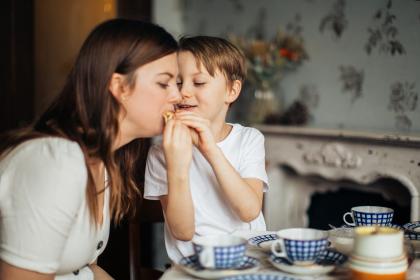During the first few years of life, children gain greater knowledge and understanding of their environments.
Introduction
They develop skills in:
- Logic
- Reasoning
- Observation
- Imagination
- Problem-solving
Learning is facilitated and mediated by development of cognitive skills that include:
- Attention
- Memory
- Sensory awareness
- Analysis
- Interpretation
Exploration, play, repetition, and elaboration are key elements of these complex developing brain processes. Children connect learning experiences with their life and see the relevancy of the new knowledge. A child’s culture is foundational to how the child learns to use these process skills.
The early childhood years encompass significant development of the child’s brain as well as the emergence of language and thinking. At birth, a child’s brain is nearly 30% developed; and by age 5, the brain is over 90% developed (Shonkoff & Phillips, 2000). This rich and unique time of growth creates the foundation for later academic learning. The indicators in this domain are aligned with the Idaho K-12 Standards and are grounded in the research and best practices of early childhood development.
For the purposes of the Idaho Early Learning eGuidelines, Domain 4: General Knowledge is divided into sub domains:
- Mathematics and Numeracy
- Science
- Social Studies
- Family, Community, and Culture
- Creative Arts
Mathematics and Numeracy skills include skills for understanding and using numbers and quantity, special relations, numerous mathematical operations, measurements, and properties of ordering. These skills are essential for children to effectively navigate mathematical situations that arise in everyday life. (National Council of Teachers of Mathematics, 2009)
Science: Scientific thinking and knowledge skills include observation, building an understanding of cause and effect in the natural world, and making predictions. It is the development of scientific thinking that helps children apply and test their knowledge through methodical inquiry and verification. By acquiring scientific knowledge, children gain an understanding of and information about their surroundings.
Social Studies: Developing knowledge of social studies allows children to understand how people interact with and relate to the people in the world around them. Children learn about government/civics through personal experiences as a family member, as a classroom member, and as a member of the community in which they live. Children start to learn about democracy by having many opportunities to live, work, and resolve problems with others. Preschool experiences help children understand and respect their own history, how people are similar and different from each other, and how people in communities help each other.
Social studies are defined as the integrated study of the social sciences. The social studies curriculum draws upon such disciplines as anthropology, archaeology, economics, geography, history, law, philosophy, political science, psychology, sociology, and world affairs. Here, social studies include:
- History and historical reasoning (includes concepts about time, past and future)
- Geography (includes weather, land forms, and impact of geography on humans)
- Economics (includes understanding very basic concepts of money markets)
- Ecology (includes the natural world around us)
- Technology
The goals in this section are based on recommendations from the Idaho State Department of Education Social Studies Position Statement, (2010-2016).
Family, Community and Culture: This aspect of cognitive development involves children learning how to interact with people in their families and the larger community.
Creative Arts: Children’s ability to express and represent themselves through movement, music, theater, and visual arts are an outgrowth of cognition. Expressing and representing ideas through the arts is paired with an understanding and appreciation of the arts. The arts give children ways to express their feelings, experiences, and meanings in ways that go beyond the limits of language. This includes learning the symbolic and cultural arts traditions of their community and culture.
Children differ in their rates of acquiring general knowledge and in the ways in which they learn, remember, and understand. For example, some children favor logical reasoning to tackle a learning task, while others take a creative or movement-based approach. Differences in children’s cognitive approaches are not and should not be viewed as deficits. Some children who have disabilities, developmental delays, or who are at risk for developmental delays, may require adaptations to support their development.
Revisions: Updated language, Social Studies introduction, and parent strategies
- Introduction – Additional language on social studies instruction
- Caregiver strategies added - Goal 39, 36-60 months: Children demonstrate understanding of numbers, ways of representing numbers, relationships among numbers, and number systems
- Caregiver strategies added- Goal 40, 36-60 months: Children demonstrate understanding of measurable attributes of objects and the units, systems, and processes of measurement (including size, volume, height, weight, length, area, and time).
- Caregiver strategies added - Goal 42, 36-60 months: Children observe, describe, and collect
information by exploring the world around them.
- Caregiver strategies added - Goal 43, 36-60 months: Children further engage in exploring and making sense of the natural world by asking questions and making predictions about cause and effect relations that can lead to generalizations.
- Caregiver strategies added - Goal 44, 36-60 months: Children differentiate between people, places, activities, and events in the past and present that relate to self, group identity, and a sense of their community.
- Caregiver strategies added - Goal 45, 36-60 months: Children demonstrate awareness and understanding of individual fairness, group rights, and responsibilities (democratic ideals) for membership and participation in group activities (successful citizenship).
- Caregiver strategies added - Goal 46: Children use creative arts to express and represent what they know, think, believe, or feel.
- 36-60 months
- 60 Months through Kindergarten
- Caregiver strategies added - Goal 47, 16-38 months: Children demonstrate understanding and appreciation of creative arts.
